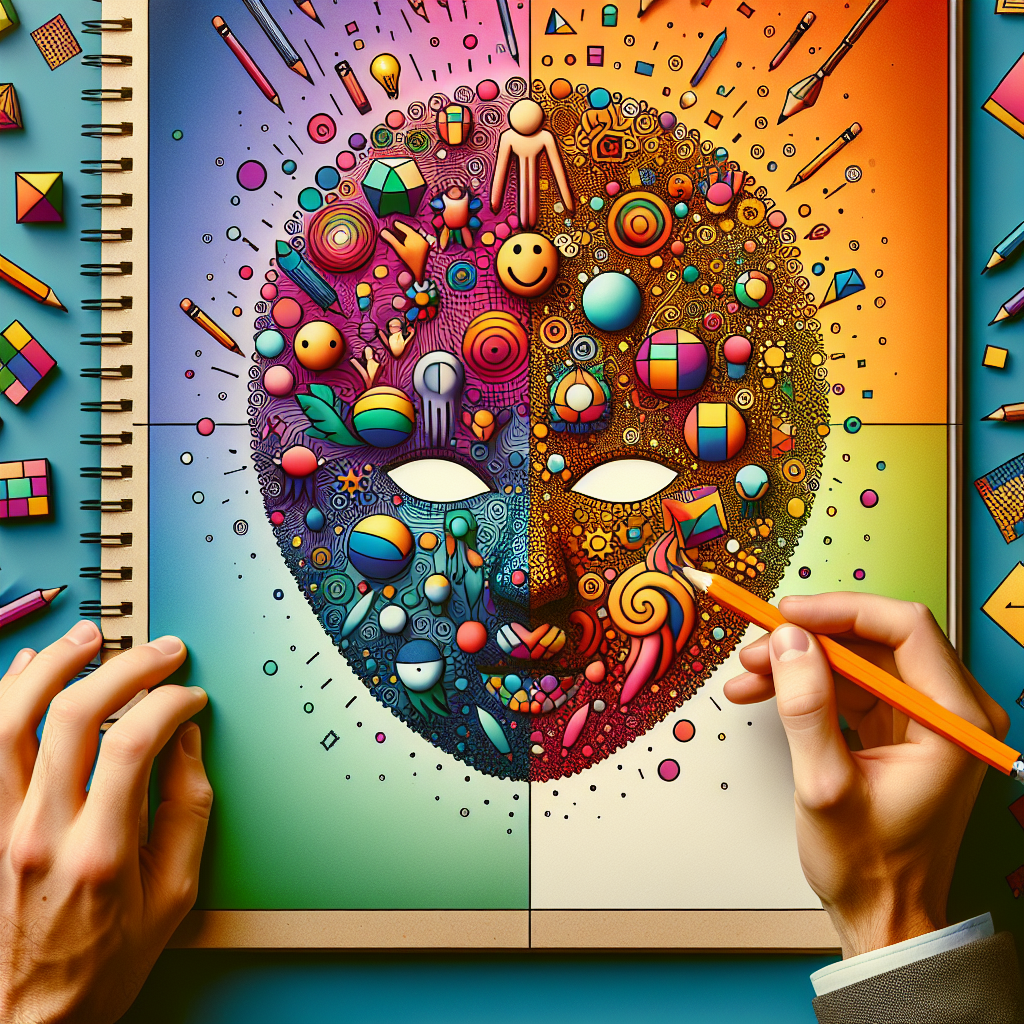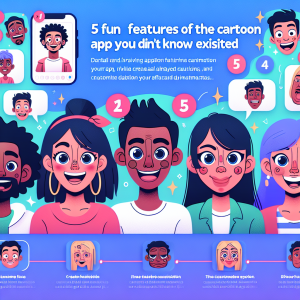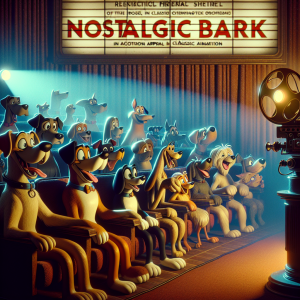Have you ever stared at a blank canvas, hoping for a bolt of inspiration that never strikes? You’re not alone! Many artists face that daunting moment where creativity seems to be hiding somewhere far away. But what if I told you that you could spark your imagination simply by unmasking the limits of your creativity through faceless cartoon art? This unique style allows you to express emotions, stories, and vibrant scenes without focusing on the minutiae that often bog us down. Intrigued? Let’s dive into the fantastic world of faceless cartoon art and explore how to unleash your inner artist!
What is Faceless Cartoon Art?
Faceless cartoon art is a delightful form of illustration where characters are portrayed without facial features. This style invites the observer to react to the body language and overall design rather than the facial expressions typically found in traditional cartoon art. By stripping away complexity, artists can create powerful narratives and emotions in their work, allowing viewers to interpret the characters in their own way. The beauty of this approach lies in its simplicity and open-ended nature, making it accessible for anyone, regardless of their drawing skills.
Why Choose Faceless Cartoon Art?
You might wonder, why choose this specific style of art? The allure of faceless cartoon art is multi-faceted:
- Versatility: Faceless cartoon art can be adapted to various themes, from whimsical to serious. It’s a versatile medium for storytelling.
- Simplification: It removes the pressure of perfecting facial features, encouraging creativity to flow more freely.
- Emotional Connection: By focusing on body language and positions, artists can evoke feelings in the audience that facial features might overshadow.
- Accessibility: Anyone can create faceless characters; you don’t need advanced artistic skills to get started.
Essential Tools for Creating Faceless Cartoon Art
Before we get into the nitty-gritty of creating your faceless masterpieces, let’s chat about the tools you might need. Surprisingly, you don’t need to invest in expensive equipment to begin your journey!
Traditional Tools
- Pencils: A simple pencil and eraser can be your best friends. Use them to sketch out ideas and compositions.
- Markers and Pens: Once you’ve finalized your sketch, outline your characters using fine-tipped markers for bold lines.
- Colored Pencils or Watercolors: To add a splash of color and bring your characters to life, consider using colored pencils or watercolors.
Digital Tools
- Graphic Tablets: These can be perfect for creating art digitally. They come in various sizes and price ranges.
- Software: Popular programs like Adobe Illustrator, Procreate, or even free software like Krita offer powerful tools for digital illustration.
Finding Your Inspiration
Now that you’re armed with tools, where should you look for inspiration? Here are some fantastic sources to ignite your creativity:
- Everyday Life: Observe the world around you. Capture moments, body language, and interactions that resonate with you.
- Social Media: Platforms like Instagram, Pinterest, or even TikTok can provide a wealth of visual ideas and tutorials. Follow artists you admire!
- Art Challenges: Participate in online art challenges, or create your own! Challenges like Inktober or Draw This In Your Style can open new doors for creativity.
- Nature: Take a walk outside. Nature can inspire shapes, colors, and forms that breathe life into your work.
Basic Techniques for Faceless Cartoon Art
Now that you’ve got your tools and sources of inspiration, it’s time to put pencil to paper (or stylus to tablet). Here are some basic techniques to get you started:
1. Focus on Body Language
Without facial features, the character’s body language is key. Think about how poses can convey mood and emotion. A slouched figure might indicate sadness, while an open posture could suggest happiness or excitement. Play with different poses to see how they can tell your story.
2. Play with Color
Color plays a massive role in creating emotions. Choose a color palette that aligns with the scene or character emotions you want to convey. Warm colors (reds, yellows) often evoke energy and happiness, while cool colors (blues, greens) can bring feelings of calmness or sadness.
3. Experiment with Proportions
Pushing the limits of proportions can create unique and whimsical characters. Try exaggerating certain features like arms or legs to create caricature-like appearances. Don’t be afraid to bend the rules a little!
4. Add Unique Accessories
Accessories can add depth and silhouette to your characters. Hats, scarves, and even unusual clothing can make faceless characters more relatable and interesting without needing facial expressions. Think about how accessories can hint at the character’s personality.
5. Create Backgrounds Wisely
Backgrounds can set the stage for your characters. Consider how the environment relates to the emotions you wish to convey. A chaotic background can heighten tension, while tranquil scenes can enhance a feeling of serenity.
Developing Your Style
Every artist has their flair. As you practice faceless cartoon art, you’ll begin to notice patterns and styles that resonate with you. Here are some tips to help you develop your unique artistic voice:
- Keep a Sketchbook: Let your ideas flow freely without the pressure of perfection. Use your sketchbook to explore various ideas and styles.
- Analyze Other Artists: Look at your favorite faceless cartoon artists and try mimicking their techniques. Over time, you’ll blend those influences into your unique style.
- Stay Open to Change: Your style will evolve as you create more. Embrace that change, and don’t shy away from trying new things.
Sharing Your Work with the World
Creating art is a beautiful journey, but sharing it can enhance the experience. Here are a few ways to get your artwork out there:
1. Use Social Media
Platforms like Instagram, TikTok, and Twitter are excellent for connecting with the art community. Make sure to hashtag your work appropriately to reach a broader audience!
2. Join Online Communities
Websites like DeviantArt, ArtStation, or specialized forums can provide valuable feedback and a sense of belonging. Engaging with fellow artists can inspire and motivate you.
3. Share Your Processes
Consider creating time-lapse videos, tutorials, or progress shots. Sharing your creative process can attract attention—people love to see how art is made!
Acknowledging Your Growth as an Artist
As you immerse yourself in faceless cartoon art, it’s vital to acknowledge your growth. Track your progress, celebrate milestones, and don’t be discouraged by setbacks. Every piece you create is a stepping stone to becoming a better artist. Here are some ways to recognize your development:
- Set Goals: Establish achievable short-term and long-term goals to motivate yourself.
- Reflect Regularly: Periodically look back at your earlier works. You’ll often be surprised at how much progress you’ve made!
- Stay Passionate: Remember why you started creating! Keep that passion alive, as it’s the driving force behind your creativity.
Frequently Asked Questions (FAQ)
What materials do I need to start creating faceless cartoon art?
To start creating faceless cartoon art, you’ll need basic tools such as pencils, erasers, markers or fine-tipped pens, and colored pencils or watercolors. If you prefer digital art, consider using a graphic tablet and software like Procreate or Adobe Illustrator.
Do I need advanced drawing skills to create faceless cartoon art?
No, you don’t need advanced skills! Faceless cartoon art is designed to be accessible to beginners. The stress of perfecting facial features is removed, allowing you to focus on expressions through gestures and body language.
How can I find inspiration for my art?
Inspiration can be found in many places! Observe your surroundings, follow artists on social media, participate in art challenges, or immerse yourself in nature. Keeping a sketchbook can also be a great way to jot down ideas that come to you.
What techniques can I use to convey emotions in faceless cartoon art?
Conveying emotions without facial features relies on body language, poses, color choices, and unique accessories. Experimenting with proportions and positioning can evoke various feelings, so be creative!
How can I share my faceless cartoon art with others?
You can share your artwork through social media platforms like Instagram and TikTok, participate in online art communities, or create time-lapse videos showcasing your creative process. Engaging with others can offer support and motivate you to continue creating.
Can I develop my own style in faceless cartoon art?
Absolutely! As you practice, you’ll start to notice patterns and preferences in your work. Keep exploring different techniques, analyze your favorite artists, and allow your style to evolve over time.
So, are you ready to step into the delightful world of faceless cartoon art? Unmask your creativity, embrace the joy of drawing, and who knows—your next masterpiece could be just around the corner! Happy creating!








+ There are no comments
Add yours